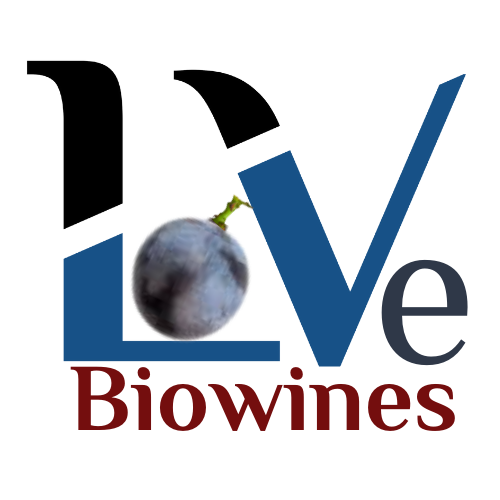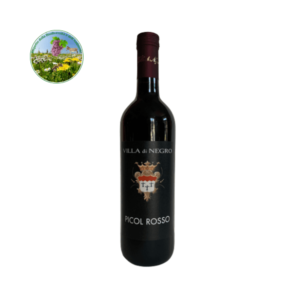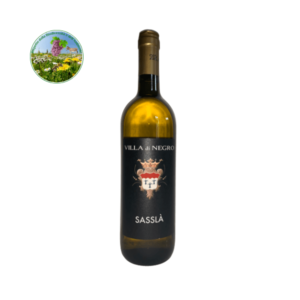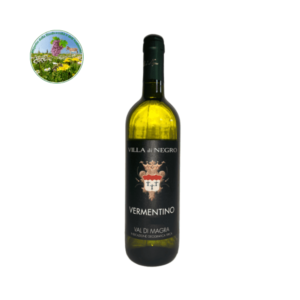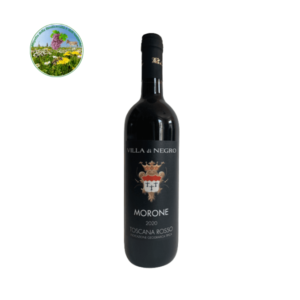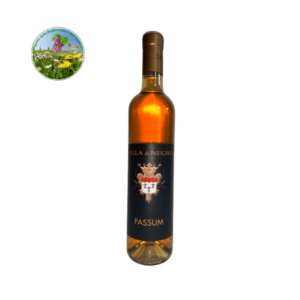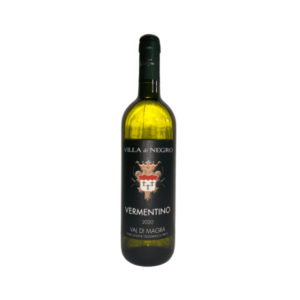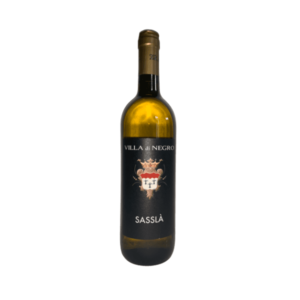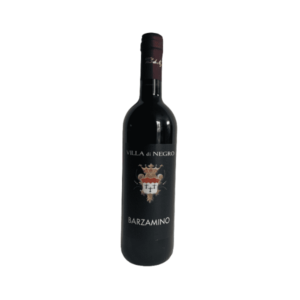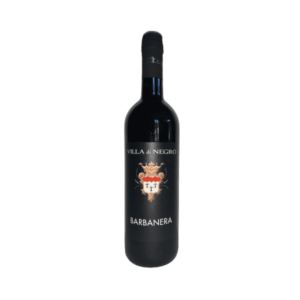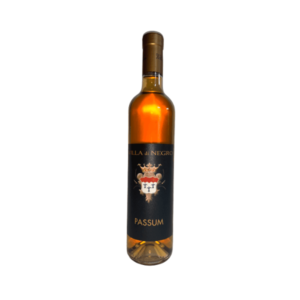




Villa di Negro: “We are committed to producing fine wines that enrich the taste and soul”
In the beautiful Lunigiana, in Pagazzana di Bagnone, a land of Tuscany, already famous in the past for its wines, the result of vines imported from France at the end of the 19th century, by the great-great-grandfather of the Di Negro family, stands the Sartori Clelia Farm
The position of the vineyards, which extend over the first hilly spurs of the upper Lunigiana, together with the careful selection of the grapes and the care during winemaking, make the bouquet of these wines particularly balanced and harmonious

Wineries and Wines NOT Certified Organic:
Two and a half hectares of planted area and environmentally friendly agriculture: no herbicides and grassy vineyards, few systemic products and treatments with copper and sulfur; in the cellar low doses of sulfur
Alta Lunigiana, Bagnone
And so Clelia and Giancarlo start a farm,
with the advice of the oenologist Giorgio Baccigalupi (a reference figure for the whole of Levante Liguria and the surrounding areas), the collaboration of his children (both lawyers but who willingly participate in this cultural operation, even before the commercial one) and the inspiration of her, who designs the wine label (she is a graduate of the Academy of Fine Arts).
New vineyards are planted and flanked by the renewed international “Francesa”, taking advantage of their grafted shoots, the local ciliegiolo, pollera, vermentino, trained with the guyot system to guarantee quality, with a few buds that ensure more sugar content and aromatic components.
The soils are medium-textured, tending to clayey, with the presence of stones, well drained. The climate, temperate, enjoys the mountain influences of the nearby Apennines and the maritime influences of the Tirreno Sea. The sunshine is excellent and lasts until October, while the temperature range between night and day is good. In short, ideal pedoclimatic conditions in vineyards that you do not expect, immersed as they are in dense vegetation that has swallowed up land that is now unfortunately abandoned.
The work of recovery and development of the Villa Di Negro Winery is therefore valuable, to the benefit of the collective memory of the agro-forestry-pastoral tradition of the area, of the tourist-cultural offer (the villa is rented in summer) and, above all, of the Lunigiana viticulture.
Two and a half hectares of planted area and environmentally friendly agriculture: no herbicides and grassy vineyards, few systemic products and treatments with copper and sulfur; in the cellar low doses of sulfur In 10 years of activity, the initial production of 600 bottles has grown to 20,000 today, with two Vermentinos, four reds and a passito.
Wines
-

Villa di Negro – Barzamino
€13.90 -

Villa di Negro – Picol Rosso
€13.90 -

Villa di Negro – Barbanera
€13.90 -

Villa di Negro – Sasslà
€13.90 -

Villa di Negro – Vermentino IGT Val di Magra
€14.90 -

Villa di Negro – Morone Igt Toscana
€15.90 -

Villa di Negro – Morone Barricato IGT Toscana
€23.90 -

Villa di Negro – Passum 50cl
€27.90
CHARACTERISTICS OF THE WINES
Vermentino – Igt Val di Magra
Vermentino – Igt Val di Magra
Grape: Vermentino
Production area: Bagnone
Soil type: medium-textured with presence of stones
Altitude: Southwest 300 meters above sea level
Year of implantation: 2004
Training system: Guyot
Plant per hectare: 6000
Harvest: 4th week of September
Vermentino – Igt Val di Magra
Straw yellow with pale golden reflections
Vermentino – Igt Val di Magra
It must be served not too cold so that it is not grumpy on the nose and can express hints of ripe annurca apple and delicate floral notes of chamomile.
Vermentino – Igt Val di Magra
On the palate it is balanced, more driven towards acidity than flavor, slightly astringent and with an almond finish.
Vermentino – Igt Val di Magra
24-36 hours of maceration on the skins, rest in steel barrels for 3 months on the lees and refines another 3 in the bottle. 12,5%.
Vermentino – Igt Val di Magra
It goes well with pasta dishes, fish, white meats and cheeses.
Vermentino – Igt Val di Magra
It must be served not too cold so that it is not grumpy on the nose and can express hints of ripe annurca apple and delicate floral notes of chamomile.
Serve at 12°-14° C
Vermentino – Igt Val di Magra
Sasslà
Sasslà
Grapes: Vermentino and Trebbiano
Production area: Bagnone
Soil type: medium-textured with presence of stones
Altitude: Southwest 300 meters above sea level
Planting year : 1990
Training system: Guyot
Plant per hectare: 5000
Sasslà
The color is straw yellow with golden reflections
Sasslà
The bouquet is harmonious and fruity
.
Sasslà
soft, delicate and fresh flavour with a long persistence
It has a mellow sweet cadence, a more rounded taste, which however does not diminish the freshness.
Sasslà
90% vermentino and 10% sauvignon, to which fermentation was stopped to obtain a residual sugar of 16-18 g / l.
Sasslà
Very pleasant with light appetizers, dry soups, fish and white meats
Sasslà
Serve at 12° – 14° C
Morone Igt Toscana
Morone Igt Toscana
Grapes: Grapes : Merlot and Pinot Nero
Production area: Bagnone
Soil type: medium-textured with presence of stones
Altitude: Southwest 300 meters above sea level
Planting year : 2005
Training system: spurred cordon and Guyot
Plant per hectare: 6000
Harvest: 4th week of September
Morone Igt Toscana
Ruby of beautiful shine, Intense red
Morone Igt Toscana
Great wine with a strong aroma
Morone Igt Toscana
Strong, full and dry taste. Particularly balanced bouquet
Morone Igt Toscana
Method and duration of refinement : 3 months in stainless steel and 3 months in the bottle
Morone Igt Toscana
It goes perfectly and melodiously with dishes with an accentuated flavor, roast meats, game and cheeses.
Morone Igt Toscana
Serve at 18°-20° C
Morone Igt Toscana
Morone Barricato Igt Toscana
Morone Barricato Igt Toscana
Grapes: Grapes : Merlot and Pinot Nero
Production area: Bagnone
Soil type: medium-textured with presence of stones
Altitude: Southwest 300 meters above sea level
Planting year : 2005
Training system: spurred cordon and Guyot
Plant per hectare: 6000
Harvest: 4th week of September
Morone Barricato Igt Toscana
Concentrated ruby
Morone Barricato Igt Toscana
Intense nose of cherry, small dark berry fruits and tamarind. Followed by recognitions of lavender and dried rose, then a herbaceous note and a slight spiciness of pepper to liven up the bouquet.
Morone Barricato Igt Toscana
In the mouth it is taut, with a vibrant acidity that accompanies the sip, warm and lean at the same time. The tannin is integrated and the sapidity is delicate at the end.
Morone Barricato Igt Toscana
version aged in barriques (oak barrels)
- Method and duration of refinement : 3 months in stainless steel 6 months in oak barrels and 3 months in bottle
Morone Barricato Igt Toscana
It goes perfectly and melodiously with dishes with an accentuated flavor, roast meats, game and cheeses.
Morone Barricato Igt Toscana
Serve at 20°-22° C
Morone Barricato Igt Toscana
Barzamino
Barzamino
Grapes: Merlot – Pinot Noir – Pollera and Ciliegiolo
Production area: Bagnone
Soil type: medium-textured with presence of stones
Altitude: Southwest 300 meters above sea level
Planting year : 1990
Training system: Guyot
Plant per hectare: 5000
Harvest : 4th week. September-1st week October
Barzamino
Barzamino
Barzamino
Enjoyable wine, young, cool and slightly semi sweet that maintains the fragrance and taste of the native grapes intact.
Barzamino
Method and duration of refinement : 3 months in stainless steel and 1 months in bottle
Barzamino
The soft taste and fragrant bouquet renders this wine ideal to combine with first course meals, light meals, boiled meat and mixed grill of white meats.
Barzamino
Service at 14°-16° C
Barzamino
Picol Rosso
Picol Rosso
Grapes: Merlot – Pinot Noir – Pollera and Ciliegiolo
Production area: Bagnone
Soil type: medium-textured with presence of stones
Altitude: Southwest 300 meters above sea level
Planting year : 1990
Training system: Guyot
Plant per hectare: 5000
Harvest : 4th week. September-1st week October
Picol Rosso
Ruby color
Picol Rosso
intense aroma.
Picol Rosso
It has a good structure
It is a wine characterized by softness, balance and pleasant persistence
Picol Rosso
- Method and duration of refinement : 3 months in stainless steel and 3 months in the bottle
Picol Rosso
Its determined, full and dry taste adapts best with meals that have a market taste, roasts, game and cheeses
Picol Rosso
Serve at 16°-18° C
Picol Rosso
Barbanera
Barbanera
Grapes: Merlot – Pinot Noir – Syrah – Pollera – Ciliegiolo
Production area: Bagnone
Soil type: medium-textured with presence of stones
Altitude: Southwest 300 meters above sea level
Planting year : 1990
Training system: Guyot
Plant per hectare: 5000
Harvest : 4th week. September-1st week October
Barbanera
Velvety, intense, ruby-coloured red;
Barbanera
the sense of smell allows you to clearly recognize the red fruits of the forest (blackberries, raspberries, etc.) very grassy spices, up to pine needles.
Barbanera
The taste is deep, persistent and tendentially solid
Barbanera
Method and duration of refinement : 3 months in stainless steel and 3 months in the bottle
Barbanera
Wile from all meals, particularly suitable for second couses
Barbanera
Serve at 16°-18° C
Barbanera
Passum
Passum
Grape: Muscat
Production area: Bagnone
Soil type: medium-textured with presence of stones
Altitude: Southwest 300 meters above sea level
Planting year : 1990
Training system: Guyot
Plant per hectare: 5000
Harvest: 1st week of October and natural drying on racks.
Passum
Crystalline amber yellow
Passum
It releases aromas of medicinal herbs integrated with notes of candied citrus, dried figs and raisins
Passum
In the mouth it is full, rich and silky, a velvet in which sweetness and acidity are in perfect balance.
Passum
Sweet dessert and meditation wine made from withered native Muscat grapes harvested in the first week of October. After withering for 45-50 days, in stackable boxes, the grapes are manually destemmed grain by grain. Aging takes place in steel tanks for 6 months and for 3 months in the bottle. 14%.
